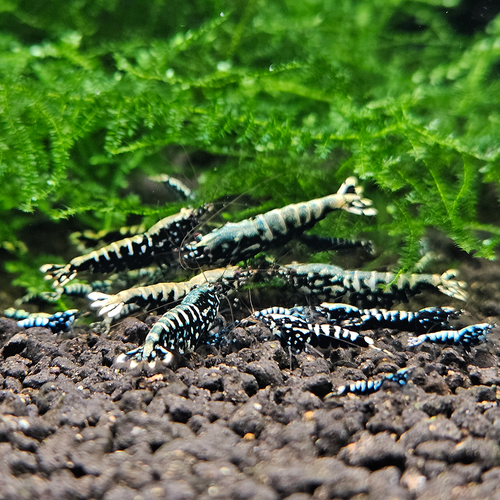So you have decided to set up a Cherry Shrimp Tank. First things first, they love a matured tank, so Cherry Shrimp are not the best choice to put in a brand new tank. Cycling the tank is VERY important, so this is step number one.
To properly cycle a tank for shrimp, you must have patience. Not only do you want a 100% completed nitrogen cycle, you want the tank to mature a little. This will assure your tanks cycle is solid, and it will allow for algaes that the shrimp graze on to grow in the tank. I personally use seeded sponges (putting a sponge filter in an already established tank to run and build the beneficial bacterial colony required) to set up in the new tank. Now there are a couple ways to continue the cycle, and it all depends on your comfort level, and how long you let the sponge seed in the established aquarium. Usually, for me, the sponge filter already has enough bacteria to hold a cycle for a small fish, so I will add a small fish (usually some of my guppy fry culls) and use Prime until I know the nitrogen cycle has completed, by testing ammonia, nitirites, and finally nitrates.
If you do not have the ability to pre-seed your filter, then you must start from scratch. This is not something you should do "fish-in". Starting from scratch means that you must set up your tank, filter, and everything brand new, with no seeded media. You are building your beneficial bacteria colony from scratch...and this can tank upwards of a month or more. Basically all you have to do after setting up the tank, is either put in a piece of food to start the process (it will break down, and start producing what is required to begin the cycle) OR you could go straight to dosing ammonia. To do this, I would highly suggest using Dr. Tim's Ammonium Chloride, as typically the ammonia you buy at the grocery store will contain surfactants (soaps) that are detrimental in the cycling process. I dose up to 4 PPM ammonia (when testing with the API test kit), and recheck a week later. Keep redosing up to 4 ppm as needed. You will begin to see nitrites once your ammonia levels start dropping. This is a good sign, and it means that you have successfully started the nitrogen cycle. This first set of bacteria is here to convert your ammonia, into nitrites. Now, you must keep feeding that bacteria ammonia, so it can keep producing nitirites. Once you have that going, a new set of bacteria should start forming, converting your nitrites into nitrates. Once you start seeing Nitrates, that means that you have all the bacteria needed, and you just have to keep feeding it until it is built up enough to sustain the bioload you are about to put in the tank. If you can dose 1ppm ammonia, and it is fully converted to nitirites, and then to nitrates, your cycle is complete. You will know this because your tests will show 0 ammonia, 0 nitiries, and a readable level of nitrates. The only way to remove nitrates is either with plants, or with your regular water changes.
At this point, I still like my tank to sit for another few weeks at minimum, but since your nitrogen cycle is complete, you may add a fish or snails to continue to feed the bacteria important to your nitrogen cycle. At this point, I like to add things such as moss's, plants, cholla or driftwood, Indian Almond Leaves, Alder Cones, rock piles or anything to be used as a "nursury" for your baby shrimp, if you haven't added it already. Adding these in while the tank matures, will allow biofilm and algaes to grow on these surfaces as well, allowing more places for shrimp to graze when they're introduced. I try to let this sit for another month, after the nitrogen cycle is complete, but my impatience usually gets the best of me a few days early, and that is ok.
For me, I like to do a solid 50-75% water change the night BEFORE adding my shrimp to the tank. Good clean water and the perfect parameters will help your new shrimp adjust well. Keeping up with the 10% weekly water changes and you will have a happy thriving colony in no time! Always drip acclimate your shrimp!
To properly cycle a tank for shrimp, you must have patience. Not only do you want a 100% completed nitrogen cycle, you want the tank to mature a little. This will assure your tanks cycle is solid, and it will allow for algaes that the shrimp graze on to grow in the tank. I personally use seeded sponges (putting a sponge filter in an already established tank to run and build the beneficial bacterial colony required) to set up in the new tank. Now there are a couple ways to continue the cycle, and it all depends on your comfort level, and how long you let the sponge seed in the established aquarium. Usually, for me, the sponge filter already has enough bacteria to hold a cycle for a small fish, so I will add a small fish (usually some of my guppy fry culls) and use Prime until I know the nitrogen cycle has completed, by testing ammonia, nitirites, and finally nitrates.
If you do not have the ability to pre-seed your filter, then you must start from scratch. This is not something you should do "fish-in". Starting from scratch means that you must set up your tank, filter, and everything brand new, with no seeded media. You are building your beneficial bacteria colony from scratch...and this can tank upwards of a month or more. Basically all you have to do after setting up the tank, is either put in a piece of food to start the process (it will break down, and start producing what is required to begin the cycle) OR you could go straight to dosing ammonia. To do this, I would highly suggest using Dr. Tim's Ammonium Chloride, as typically the ammonia you buy at the grocery store will contain surfactants (soaps) that are detrimental in the cycling process. I dose up to 4 PPM ammonia (when testing with the API test kit), and recheck a week later. Keep redosing up to 4 ppm as needed. You will begin to see nitrites once your ammonia levels start dropping. This is a good sign, and it means that you have successfully started the nitrogen cycle. This first set of bacteria is here to convert your ammonia, into nitrites. Now, you must keep feeding that bacteria ammonia, so it can keep producing nitirites. Once you have that going, a new set of bacteria should start forming, converting your nitrites into nitrates. Once you start seeing Nitrates, that means that you have all the bacteria needed, and you just have to keep feeding it until it is built up enough to sustain the bioload you are about to put in the tank. If you can dose 1ppm ammonia, and it is fully converted to nitirites, and then to nitrates, your cycle is complete. You will know this because your tests will show 0 ammonia, 0 nitiries, and a readable level of nitrates. The only way to remove nitrates is either with plants, or with your regular water changes.
At this point, I still like my tank to sit for another few weeks at minimum, but since your nitrogen cycle is complete, you may add a fish or snails to continue to feed the bacteria important to your nitrogen cycle. At this point, I like to add things such as moss's, plants, cholla or driftwood, Indian Almond Leaves, Alder Cones, rock piles or anything to be used as a "nursury" for your baby shrimp, if you haven't added it already. Adding these in while the tank matures, will allow biofilm and algaes to grow on these surfaces as well, allowing more places for shrimp to graze when they're introduced. I try to let this sit for another month, after the nitrogen cycle is complete, but my impatience usually gets the best of me a few days early, and that is ok.
For me, I like to do a solid 50-75% water change the night BEFORE adding my shrimp to the tank. Good clean water and the perfect parameters will help your new shrimp adjust well. Keeping up with the 10% weekly water changes and you will have a happy thriving colony in no time! Always drip acclimate your shrimp!




